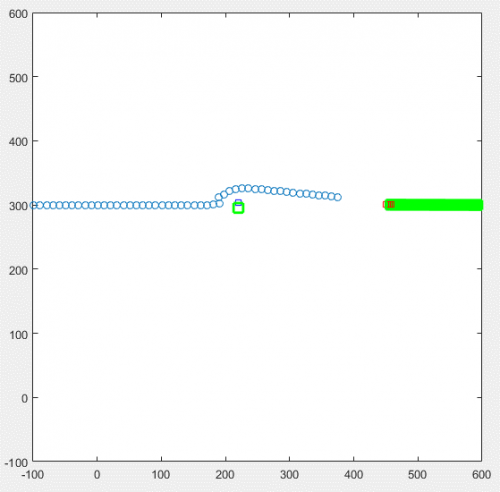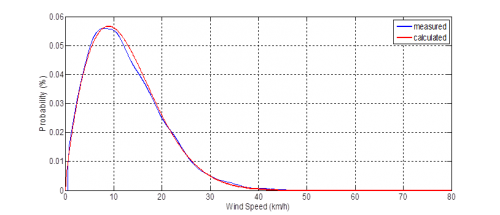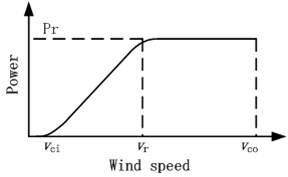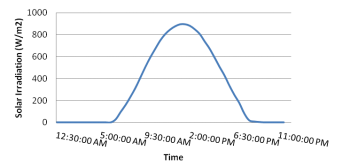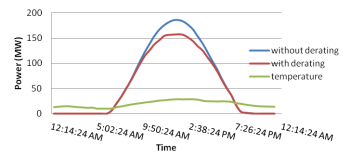Projects:2014s2-82 Grid Integration of Solar PV Embedded Generation
Contents
Project Information
Modeling and Probabilistic Analysis
Modeling
The power system uncertainty modeling includes models of power system demand, wind power generation and solar PV generation.
Power System Demand
Based on literature review the power system demand can be modelled by normal distribution. And the demand is normally varying in regions, in different dates and seasons, so for a regional demand the models are split up in a warmer and a cooler period, further, split up in weekdays and weekends. Meanwhile due to the high ambient temperature in warmer period, the demand curve is significantly different when the temperature is over 35℃, so for warmer period the demand model will be split up further by the temperature. And as an example, the 6 different types of mean value of demand curve from Metro Region are shown in Figure 1.
Wind Power Generation
Based on literature review, wind speed in a region can be modelled by a two-parameter Weibull distribution. As an example, the measured probability density function of wind speed in Middle North Region and corresponding formulisation of Weibull distribution are shown in Figure2.
From Figure 2, the calculated curve is well matching the measured one which indicates the wind speed can be properly modelled by Weibull distribution. And non-linear model is used to build up the relationship between wind speed and output power which is shown in Figure 3.
Solar PV Generation
Step 1: Unit daily energy is modeled by Normal distribution, Figure 4.
Step 2: Formulizing the ideal solar irradiation curve, Figure 5.
Step 3: Scale the ideal irradiation curve with ratio of unit daily energy between Step 1 and Step 2.
Step 4: Using scaled irradiation curve to calculate the PV output power with considering temperature derating, Figure 6.
Experiment and Data Analysis
Experimental Design
Main Experimental Equipment
1. YC500A Micro-inverter
2. California Instruments Power Source
Experimental Setup
Results Analysis
1. Steady-state
- Input and output waveform of inverter
- Working range of inverter
- Power factor of inverter varying with DC input
- Total harmonic distortion
2. Transient state
- Inverter working range on the main supply disturbance
- Delay time
Voltage disturbance
Frequency disturbance
Conclusion
Outcomes
Future work
Team
Group members
Hang Yin
Kai Sun
Supervisor
Dr Rastko Zivanovic [1]
Sponsor
ElectraNet [2]
References
[1] B. Bak-Jensen, J. Bech, CG. Bjerregaard, PR. Jensen, “Models for Probabilistic Power Transmission System Reliability Calculation” IEEE Transactions on Power Systems, 1999, Vol.14(3), pp.1166-1171
[2] Y. Liao, M. Zhou, “Studies on Impact of Wind Power Using Power System Probabilistic Production Simulation” 2012 Asia-Pacific Power and Energy Engineering Conference, March 2012, pp.1-4
[3] A. Hadian, M.-R Haghifam, J. Zohrevand, E. Akhavan-Rezai, “Probabilistic Approach for Renewable DG Placement in Distribution Systems with Uncertain and Time Varying Loads” 2009 IEEE Power and Energy Society General Meeting, July 2009, pp. 1-8
[4] D.H. Nguyen, M. Negnevitsky, “ Probabilistic Risk-based Security Assessment for Power System with Power Generation” 2013 IEEE Power and Energy Society General Meeting, 2013, pp. 1-5
[5] T. Alquthami, H. Ravindra, M.O. Faruque, M. Steurer, T. Baldwin, “Study of Photovoltaic Integration Impact on System Stability Using Custom Model of PV Arrays Integrated with PSS/E” North American Power Symposium, Sept 2010, pp. 1-8
[6] T. Tran-Quoc, A. Luu-Ngoc, X. Le-Pivert, J. Merten, F. Barruel, “Probabilistic Analysis of Photovoltaic Generation Impacts on Distribution Networks” 27th European Photovoltaic Solar Energy Conference and Exhibition
[7] S. Conti, S. Raiti, “Probabilistic Load Flow Using Monte Carlo Techniques for Distribution Networks with Photovoltaic” Solar Enery, 2007, Vol.81(12), pp.1473-1481
[8] M. Lu, YD. Zhao, T. K. Saha, “A Probabilistic Load Flow Method Considering Transmission Network Contingency” 2007 IEEE Power Engineering Society General Meeting, June 2007, pp.1-6
[9] M. Mosadeghy, T. K. Saha, “Reliability Evaluation of Wind Farms Considering Different Reliability Assessment Levels” 2014 IEEE Power Engineering Society General Meeting, July 2014, pp.1-5
[10] J. Sveca, L. Soder, “Wind Power Integration in Power Systems with Bottleneck Problems” 2003 IEEE Bologna Power Tech Conference Proceedings, 2003, Vol.2, p.7 pp. Vol.2
[11] C. Guido, C. Pierluigi, V. Pietro, “Multi-linear Monte Carlo Simulation Method for Probabilistic Load Flow of Distribution Systems with Wind and Photovoltaic Generation Systems” Renewable Energy, April 2015, Vol.76, pp.283-295
[12] U. Julio, “Probabilistic Load Flow with Correlated Wind Power Injections” Electric Power Systems Research, 2010, Vol.80(5), pp.528-536
[13] C. Cristina, R. Esther, R. Jesus, “Probabilistic Load Flow with Versatile Non-Gaussian Power Injections” Electric Power Systems Research, February 2015, Vol.119, pp.266-277
[14] U. Julio, “Probabilistic Load Flow with Wind Production Uncertainty Using Cumulants and Cornish-Fisher Expansion” International Journal of Electrical Power and Energy Systems, 2009, Vol.31(9), pp.474-481
[15] L. Dong, W. Cheng, H. Bao, Y. Yang, “A Probabilistic Load Flow Method with Consideration of Random Branch Outages and Its Application” 2010 Asia-Pacific Power and Energy Engineering Conference, March 2010, pp.1-4
[16] G. Li, X. Zhang, “Comparison Between Two Probabilistic Load Flow Methods for Reliability Assessment” 2009 IEEE Power & Energy Society General Meeting, July 2009, pp.1-7
[17] L. Dond, C. Zhang, Y. Yang, P. Zhang, “Improvement of Probabilistic Load Flow to Consider Network Configuration Uncertainties” 2009 Asia-Pacific Power and Energy Engineering Conference, March 2009, pp.1-5
[18] A. Da Silva, W. Sales, L. Da Fonseca Manso, R. Billinton, “Long-Term Probabilistic Evaluation of Operating Reserve Requirements With Renewable Source” IEEE Transactions on Power Systems, Feb. 2010, Vol.25(1), pp.106-116
[19] X. Liu, S. Islam, “Reliability Evaluation of a Wind-Diesel Hybrid Power System with Battery Bank Using Discrete Wind Speed Frame Analysis” 2006 International Conference on Probabilistic Methods Applied to Power Systems, June 2006, pp.1-7
[20] G. Orfanos, P. Georgilakis, N. Hatziargyriou, “Transmission Expansion Planning of Systems with Increasing Wind Power Integration” IEEE Transactions on Power Systems, May 2013, Vol.28(2), pp.1355-1362
[21] M. Bardhi, G. Grandi, G.M. Tina, “Comparison of PV Cell Temperature Estimation by Different Thermal Power Exchange Calculation Methods” International Conference on Renewable Energy and Power Quality, Santiago de Compostela, Spain, March 28-30
[22] T. Govindasamy, L. Ji, Y. Tang, “Photovoltaic Module Thermal/wind Performance: long-term monitoring and model development for energy rating” NCPV and solar program review meeting 2003
[23] S. Armstrong, W.G. Hurley, “A Thermal Model for Photovoltaic Panels under Varying Atmospheric Conditions” Applied Thermal Engineering, 2010, Vol.30(11), pp. 1488-1495
[24] A.D. Jones, C.P. Underwood, “A Thermal Model for Photovoltaic Systems” Solar Energy, 2001, Vol.70(4), pp.349-359
[25] AMETEK, “California Instruments CSW Series”, AMETEK Programmable Power, 2010
[26] APS America, "APS YC500-A photovoltaic grid-connected inverter", installation/user manual, 2014,Version 4.1 1/15
[27] APT, "Total harmonic distortion and effects in electrical power systems", Associated Power Technologies, 2012
[28] J. Bauer, J. Lettl, "Solar power station output inverter control design", Radio Engineering, 2011, VOL. 20, NO. 1
[29] B. Burger, R. Ruther, "Inverter sizing of grid-connected photovoltaic systems in the light of local solar resource distribution characteristics and temperature", Science Direct, Solar Energy, 2006
[30] S. Chowdhury, G.A. Taylor, S.P. Chowdhury, A.K. Saha, Y.H. Song, "Modelling, simulation and performance analysis of a PV array in an embedded environment", UPEC, 2007
[31] R. Gottschalg, “Performance characterisation of photovoltaic modules”, Centre for Renewable Energy Systems Technology, Department of Electronic and Electrical Engineering, Loughborough University, 2010
[32] M. Holt, "Solar photovoltaic (PV) systems", NEC Requirements for Solar Photovoltaic System, 2011
[33] Power Analytics Corporation, “Photovoltaic Modeling”, Paladin DesignBase, 2011
[34] R.G.G. Raju, N.P. Subramaniam, “Operation and Modeling of photovoltaic power generators”, Recent Advances in Space Technology Services and Climate Change, Nov. 2010, pp.466-469
[35] E. Turner, “Testing for grid-tied solar system inverters”, Electronic Products, AMETEK Programmable Power, San Diego, CA, 2010
[36] R.J. Wai, W.H. Wang, "Grid-connected Photovoltaic generation system", IEEE Xplore, 2008, Volume 55, Issue 3
